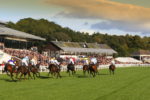Buyers purchasing a Stonestreet Farm-bred and raised yearling at this year’s Keeneland September Sale will be able to access the blood-health of their purchase following the farm’s launch of a blood sampling, testing and secure storage protocol earlier this year.
In association with the University of Kentucky’s Gluck Equine Research Center, the scheme was developed following concerned reports of off-label bisphosphonate use in growing horses.
Those who make a purchase from Stonestreet will now have the opportunity to review a blood-health window of at least six months prior to their purchase. At their own expense, a buyer can also request testing for anabolic steroids and bisphosphonates on the blood samples that remain in secure storage.
Purchasers can request any additional testing during the seven days following the fall of the hammer by completing the ‘Request to Test’ form available at Stonestreetfarms.com. Following completion of the secure storage period, the blood samples will be donated to Gluck and used in research projects.
Barbara Banke, owner of Stonestreet Farm, said: “Last year we raised and sold nearly $20,000,000 of yearlings, but our focus has always been to raise racehorses, not sale horses.
“We are proud of what we do, and I think transparency in raising a racehorse is so important. We want our buyers to have the utmost confidence in our yearlings.”
Throughout this year, samples were taken from each Stonestreet yearling on a regular schedule set out by the Gluck Equine Research Center using the current bisphosphonate periods. A third-party vet was hired by the centre to take the samples.
Scott Stanley, Professor of Analytical Chemistry at the Gluck Equine Research Center, supervised sample collection and ensured a strict chain of custody and authored documentation.
Nancy Cox, dean of the UK’s College of Agriculture, Food and Environment, said: “We applaud Stonestreet’s efforts to employ an approach driven by transparency and good science as part of their sales operation.
“We look forward to further results of this project as time goes on. This kind of project is what we do best, to merge our college’s scientific capacity with a worthy industry goal. It also displays our commitment to safety in all aspects of the equine industry.”



